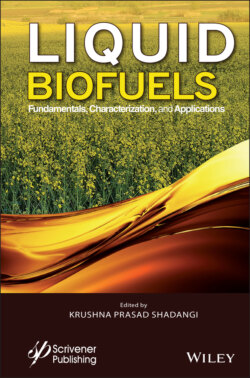Читать книгу Liquid Biofuels - Группа авторов - Страница 43
2.1 Introduction
ОглавлениеDemand for energy, mostly in terms of transportation fuel and electricity, has increased remarkably over the last few decades and will continue to grow in the future with the rising population [1, 2]. The major energy demand is fulfilled by fossil fuels such as coal, crude oil, and natural gas. Because of the limited reservoirs of conventional fossil fuels, their dwindling prices and environmental concerns, the research community has been compelled to look for alternative energy sources for sustainable development of human society. Researchers have explored several alternatives to fossil-based energy sources to fulfil the demand for electricity and transportation fuel. Among these, biodiesel has become a promising alternative to conventional diesel; it can be used in the existing diesel engine with minor alterations [3]. Using biodiesel in a diesel engine either in blended or in the pure form will reduce the detrimental effect of toxic gases on the environment [4]. Use of biodiesel can also support the sustainable development in rural areas by creating agricultural employments and a sustainable energy security for countries that are highly dependent on crude oil imports [5]. Biodiesel, being a renewable fuel, has several advantages over conventional diesel, such as higher lubricity, superior cetane number with improved combustion efficiency, reduced emission of aromatics, higher flash point, etc. [6, 7]. Technically, biodiesel is a mixture of mono-alkyl methyl esters obtained from the reaction of short-chain alcohols and triglycerides or free fatty acids [8]. Conventionally, biodiesel is prepared from vegetable oils (mostly edible only); however, the increase in demand for energy due to population growth and debate on food security over fuel supply has led to a search for non-edible feedstocks. Potential alternate feedstocks for biodiesel production are non-edible oils, animal fats, micro-and macroalgal biomass, waste cooking oil, etc. [9, 10]. Comprehensive research is being performed for successful production of biodiesels from the different feedstock. Factors such as catalyst type, reactor geometries, mixing modes, etc., positively affect the biodiesel production [2, 11]. The research in the area of biodiesel is driven by its increasing demand globally. The global production of biodiesel reached over 34 billion liters in 2018, with more than 200 industries commercially producing it [12]. As per the report of the International Energy Agency (IEA) in 2019, the production of biodiesel is expected to grow in different parts of the world except for the European Union, where the solar-driven and fuel cell driven vehicles are getting more attention in the period of the next 5 years [13]. Regional distribution of global biodiesel production (current and projected) is depicted in Figures 2.1 and 2.2.
The report of the Renewable Energy Policy Network (REN 21), published in 2014, has highlighted the attention gained by biodiesel with an annual growth rate of ~ 11.5% as an alternative fuel [14]. Different aspects of viable and economical production of biodiesel include the development of different catalysts (homogeneous, heterogeneous, acid, alkali, resins, enzymes, etc.), reactor designs (batch, continuous, packed bed, CSTR, microchannel, etc.), mode of mixing (co-solvent, microwave, ultrasound, etc.) [15–17]. Briefly, the R&D efforts in biodiesel production can be categorized in three sections: (i) development of efficient and cost-effective heterogeneous catalyst; (ii) utilization of cheaper feedstocks like non-edible oils for biodiesel production; and (iii) efficient reactor designs with novel methods with energy inputs. Each of these aspects significantly contributes to the sustainability, viability, and economy of biodiesel production.
In recent years, with a compulsory mandate from various governments, for blending 5-20% biodiesel in conventional diesel, the demand for biodiesel has increased drastically. To fulfil the demand of biodiesel, without affecting the edible oil sources for its production, alternative non-edible sources are being explored now. However, non-edible feedstocks contain high levels of free fatty acids and require pre-processing for the removal of the fatty acids. Alternatively, heterogeneous catalysts that are capable of performing simultaneous esterification and transesterification can also be used [9, 18, 19]. Among these, the use of heterogeneous catalysts to improve the overall economy of the process (lowering the downstream processing and minimizing the contamination of by-product glycerol) is more appealing. However, the use of heterogeneous catalysts makes the reaction mixture 3-phase, with substantial mass transfer limitation resulting in slower kinetics and lower yields [20–22]. Many researchers have adopted the application of novel mixing methods to address this issue, and one such efficient technique is sonication [23–26]. Sonication of liquid-liquid heterogeneous mixture results in the formation of a fine emulsion which largely overcomes the mass transfer barriers and improves the kinetics of the transesterification process. Many authors have reported the successful application of sonication or cavitation phenomenon for biodiesel production. This chapter deals with the basic principles of sonication or ultrasound irradiation in the context of process intensification, and important aspects of cavitational reactor designs (either acoustic or hydrodynamic type) for biodiesel production. Moreover, the recent advances in reactor design for biodiesel production have also been reviewed.
Figure 2.1 Cumulative production of biodiesel among various regions over the period of 2013-18
[Source: IEA report [13]].
Figure 2.2 Biodiesel production data over the period 2013-2018 and expected production of biodiesel for the period 2019-2024
[Source: IEA report [13]].
